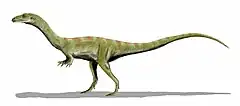| Shuvosaurus | |||
| Chatterjee, 1993 | |||
 | |||
| Systematyka | |||
| Domena | |||
|---|---|---|---|
| Królestwo | |||
| Typ | |||
| Podtyp | |||
| Gromada | |||
| Podgromada | |||
| Infragromada | |||
| Rząd | |||
| Nadrodzina |
Poposauroidea | ||
| Rodzina | |||
| Podrodzina |
Shuvosaurinae | ||
| Rodzaj |
szuwozaur | ||
| Gatunki | |||
| |||
Szuwozaur (Shuvosaurus) – rodzaj archozaura należącego do rzędu rauizuchów i rodziny Poposauridae. Żył w późnym triasie na terenie dzisiejszej Ameryki Północnej. Jego szczątki odnaleziono na terenie stanu Teksas w Stanach Zjednoczonych. Szuwozaur został opisany w 1993 przez Sankara Chatterjee, który nadał mu nazwę Shuvosaurus na cześć swojego syna Shuvo[1][2].
Początkowo szuwozaura uznano za teropoda z rodziny ornitomimów (Ornithomimidae), której przedstawiciele żyli w kredzie[1][2]. Dopiero późniejsze odkrycie archozaura Effigia dowiodło, że podobieństwo niektórych rauizuchów do ornitomimozaurów jest jedynie wynikiem konwergencji, a zwierzęta te są w rzeczywistości bliżej spokrewnione z krokodylami i należą do kladu Crurotarsi[3][4]. Badania te wykazały również, że Chatterjeea jest młodszym synonimem Shuvosaurus[5].
 Rekonstrukcja głowy Shuvosaurus inexpectatus
Rekonstrukcja głowy Shuvosaurus inexpectatus
Przypisy
- 1 2 S. Chatterjee. An unusual toothless archosaur from the Triassic of Texas: the world's oldest ostrich dinosaur?. „Journal of Vertebrate Paleontology”. 8 (3), s. 11A, 1991. (ang.).
- 1 2 S. Chatterjee. Shuvosaurus, a new theropod: an unusual theropod dinosaur from the Triassic of Texas. „National Geographic Research and Exploration”. 9 (3), s. 274–285, 1993. (ang.).
- ↑ SJ Nesbitt, MA Norell. Extreme convergence in the body plans of an early suchian (Archosauria) and ornithomimid dinosaurs (Theropoda). „Proceedings of the Royal Society B”. 273, s. 1045-1048, 2006. DOI: 10.1098/rspb.2005.3426. (ang.).
- ↑ O. W. M. Rauhut: On the cranial anatomy of Shuvosaurus inexpectatus (Dinosauria: Theropoda). W: S. Sachs, O. W. M. Rauhut, A. Weigert (red.): 1. Treffen der deutschsprachigen Palaeoherpetologen. Düsseldorf: Extended Abstracts. Terra Nostra 7/97, 1997, s. 17-21.
- ↑ SJ Nesbitt. The anatomy of Effigia okeeffeae (Archosauria, Suchia), theropod-like convergance, and the distribution of related taxa. „Bulletin of the American Museum of Natural History”. 302, s. 84, 2007. (ang.).